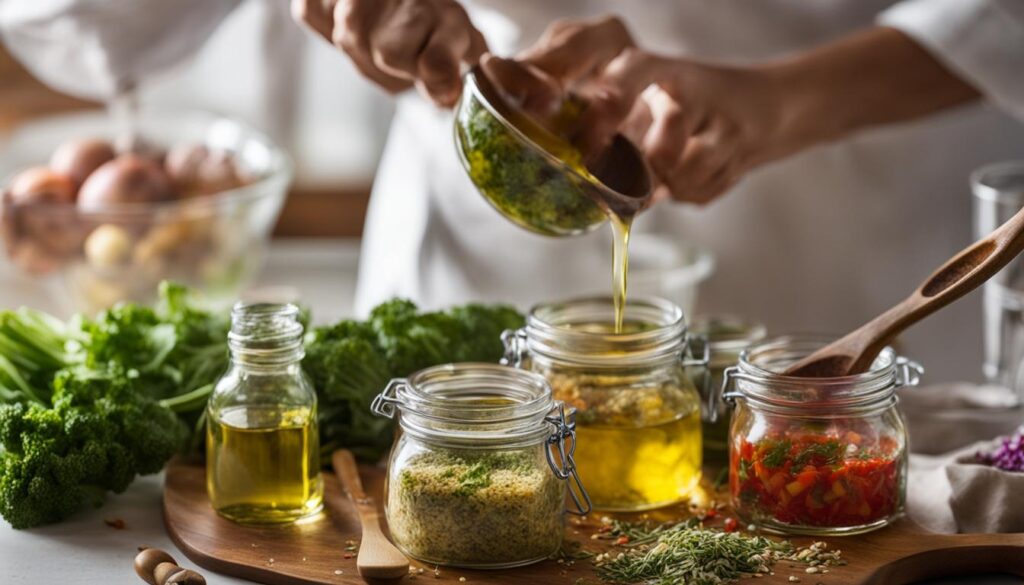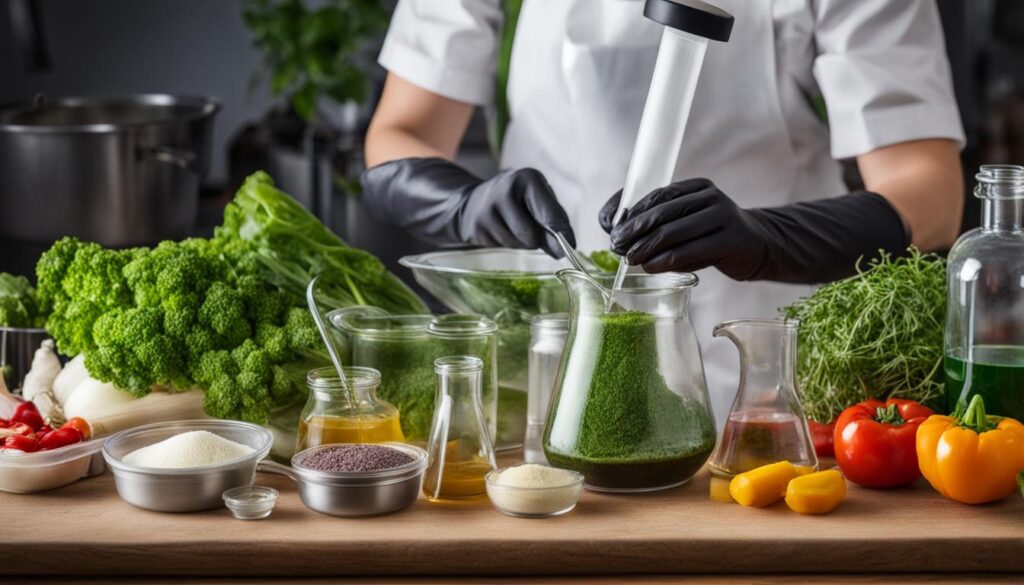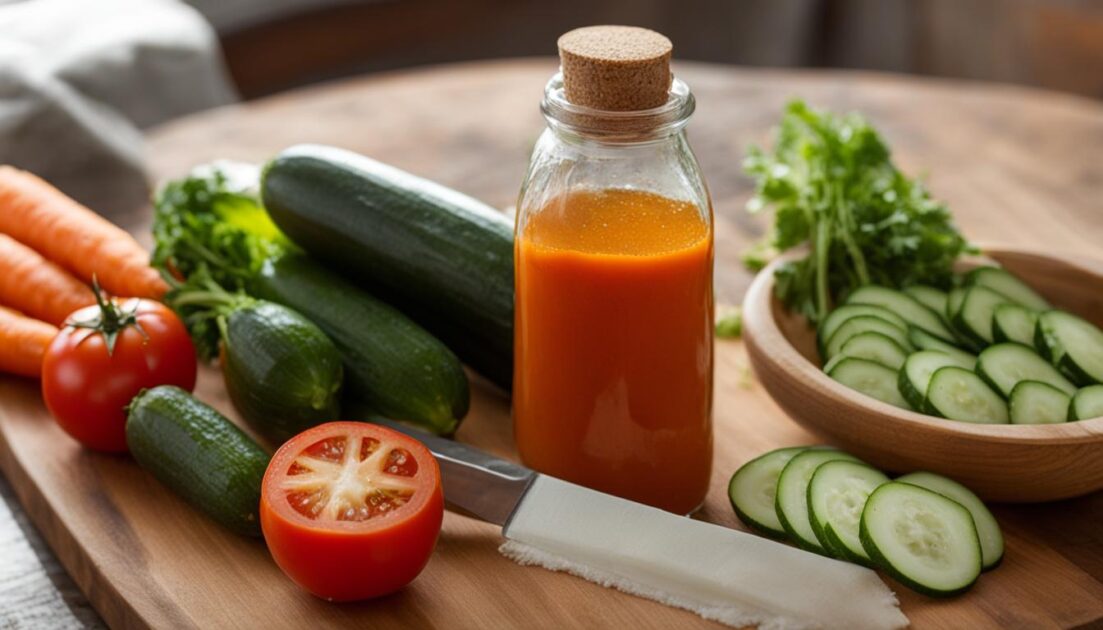Welcome to my tutorial on making homemade vegetable glycerin – a pure and natural alternative to commercial glycerin products. By following this simple recipe, you can create your own vegetable glycerin right in the comfort of your own home.
Key Takeaways:
- Creating homemade vegetable glycerin is an easy and cost-effective process.
- The ingredients and equipment needed include coconut oil, olive oil, lye, water, salt, a saucepan, safety goggles, rubber gloves, a face mask, a candy thermometer, a spoon, and an airtight glass bottle.
- Combining and heating the oils, preparing the lye mixture, and combining the lye mixture with the oils are the initial steps of the process.
- Heating and stirring the mixture, adding salt, and letting the mixture cool are the subsequent steps.
- After separating the soap and collecting the glycerin, store the homemade vegetable glycerin in an airtight glass bottle in the refrigerator for up to 4 weeks.
Gather Ingredients and Equipment
To make homemade vegetable glycerin, you’ll need a few key ingredients and equipment. Here’s what you’ll need:
- 1 cup (200 g) coconut oil
- 1 cup (240 ml) olive oil
- 2 tablespoons (30 g) lye
- 1 cup (240 ml) water
- 1/2 cup (150 g) salt
- Large saucepan
- Large bowl
- Safety goggles
- Rubber gloves
- Face mask
- Candy thermometer
- Spoon
- Airtight glass bottle
Gathering these ingredients and equipment is the first step towards producing your own high-quality vegetable glycerin. Having the right supplies ensures a smooth and efficient production process.

Now that you have everything ready, let’s move on to the next steps in the vegetable glycerin production process.
Combine and Heat the Oils
In a large saucepan, combine 1 cup (200 g) of coconut oil and 1 cup (240 ml) of olive oil. Stir the oils together until they are well combined. Place the saucepan on the stovetop and heat the oils on high until the coconut oil begins to melt.

Prepare the Lye Mixture
While the oils are heating, it’s time to prepare the lye mixture for making homemade vegetable glycerin. This step is crucial in ensuring the success of your glycerin production process.
In a heat-safe glass container, carefully measure 2 tablespoons (30 g) of lye. Then, add 1 cup (240 ml) of water to the container. It’s essential to handle lye with caution as it can be caustic and cause skin irritation. Make sure to wear safety goggles, rubber gloves, and a face mask to protect yourself from any potential hazards.
Once you’ve added the lye and water, stir the mixture well using a spoon or a whisk. It’s important to thoroughly dissolve the lye in the water to ensure its effectiveness in the glycerin-making process. Take your time to mix the ingredients until the lye is fully dissolved.
Remember, safety should always be a priority when working with lye. Make sure you’re in a well-ventilated area, preferably near an open window, to avoid inhaling any fumes. Additionally, keep children and pets away from the workspace during this process.

Adding lye to the water creates an exothermic reaction that generates heat. Be cautious not to touch the mixture, as it may get hot. Allow the lye mixture to cool down before proceeding to the next step.
Combine the Lye Mixture and Oils
Once the oils are heated and the lye mixture is prepared, carefully pour the lye mixture into the saucepan with the oils. Stir the mixture well to ensure that the ingredients are thoroughly combined.
Combining the lye mixture and oils is a crucial step in the vegetable glycerin production process. This step ensures that the lye, which acts as a catalyst, interacts with the oils to initiate the saponification process. By thoroughly stirring the mixture, you ensure that all the ingredients are well-distributed, setting the foundation for the transformation of oils into vegetable glycerin. The combination of the lye and oils forms the basis for creating a versatile and widely-used substance known for its moisturizing and emollient properties.
To achieve the best results, take your time while pouring the lye mixture into the saucepan. Slow and precise pouring helps prevent any spills or splashes. Once the lye mixture is in the saucepan, use a spoon or whisk to stir the mixture vigorously. This action ensures that the lye and oils blend together completely, setting the stage for the subsequent steps in the vegetable glycerin production process.
Heat and Stir the Mixture
To continue the vegetable glycerin process, heat the mixture in the saucepan to a temperature of 125°F (52°C). This step is crucial for achieving the desired consistency and properties of the glycerin. To monitor the temperature accurately, use a candy thermometer and ensure it reaches the specified level.
Once the mixture reaches the desired temperature, lower the heat to medium-low to maintain it. Then, begin stirring the mixture continuously for 10-15 minutes. Stirring is essential to evenly distribute the heat and promote the thickening of the mixture.
Note: During this stirring phase, you might notice the mixture thickening gradually as it cools down and transforms into vegetable glycerin. The consistency will become more viscous, indicating the conversion process taking place.
Visual representation of the heat and stirring process during the vegetable glycerin production.
| Step | Temperature | Durations |
|---|---|---|
| Heating | 125°F (52°C) | N/A |
| Stirring | N/A | 10-15 minutes |
Add Salt and Let the Mixture Cool
Once you have stirred the mixture for the specified time, it’s time to add salt and allow the mixture to cool completely. Adding salt is an important step in the vegetable glycerin process as it aids in the separation of soap and glycerin layers.
Add 1/2 cup (150 g) of salt to the saucepan and mix it well into the mixture. The salt will help remove any excess water and promote the formation of distinct soap and glycerin layers.
Next, remove the saucepan from the heat and set it aside. Allow the mixture to cool naturally without any external heat sources. As the mixture cools, you will begin to notice the separation of soap and glycerin into different layers.
It’s important to let the mixture cool fully to facilitate the separation process. This can take several hours or overnight. Patience is key during this step, as rushing the cooling process may result in incomplete separation of the soap and glycerin layers.
Once the mixture has cooled completely and the soap and glycerin have separated, you can proceed to the next step of collecting the glycerin and removing any remaining soap.
| Step | Description |
|---|---|
| 1 | Stir the mixture for the specified time |
| 2 | Add 1/2 cup (150 g) of salt and mix well |
| 3 | Remove the saucepan from heat and let the mixture cool |
| 4 | Allow the soap and glycerin to separate into different layers |
Separate Soap and Collect Glycerin
After the homemade vegetable glycerin mixture has fully cooled, it’s time to separate the soap and collect the precious liquid glycerin. Using a spoon, gently lift and remove the layer of soap that has solidified on top of the mixture. Dispose of the soap layer responsibly, as it will not be used in the final product.
Once the soap is removed, you will be left with the liquid glycerin. Carefully transfer the glycerin into an airtight glass bottle. Glass is preferred for storing glycerin as it helps to maintain its purity and quality over time. Make sure the bottle is tightly sealed to prevent any moisture or contaminants from entering.
To prolong the shelf life of your homemade vegetable glycerin, store the bottle in the refrigerator. Refrigeration helps to preserve the glycerin’s freshness and extend its usability. With proper storage, your homemade vegetable glycerin can be kept for up to 4 weeks, allowing you to enjoy its benefits for a longer period of time.
FAQ
Can I make vegetable glycerin at home?
Yes, you can easily make vegetable glycerin at home using a simple recipe. By following the steps provided, you can create your own pure and natural vegetable glycerin.
What ingredients and equipment do I need to make vegetable glycerin?
To make vegetable glycerin at home, you will need the following ingredients and equipment: 1 cup (200 g) coconut oil, 1 cup (240 ml) olive oil, 2 tablespoons (30 g) lye, 1 cup (240 ml) water, 1/2 cup (150 g) salt, large saucepan, large bowl, safety goggles, rubber gloves, face mask, candy thermometer, spoon, and an airtight glass bottle.
What is the process to make vegetable glycerin?
The process to make vegetable glycerin involves combining and heating the oils, preparing the lye mixture, combining the lye mixture and oils, heating and stirring the mixture, adding salt and letting the mixture cool, and finally separating the soap and collecting the glycerin. Detailed steps can be found in the homemade vegetable glycerin guide provided.
How long can homemade vegetable glycerin be stored?
Once made, homemade vegetable glycerin can be stored in an airtight glass bottle in the refrigerator for up to 4 weeks.
Is homemade vegetable glycerin safe to use?
Homemade vegetable glycerin made using the provided recipe and following safety precautions is generally safe to use. However, it is important to note that individual reactions may vary, so it is recommended to perform a patch test before using on larger areas of the skin.
Can I use other oils instead of coconut oil and olive oil?
Yes, you can experiment with different oils to make vegetable glycerin. However, coconut oil and olive oil are commonly used for their beneficial properties and availability.






